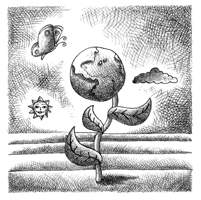In this Chapter:
- Ancient Heat Wave
- Vanishing Villain
- Rainwater “Archives”
- World Oceans and Global Climate
- Dust Is in the Air
- Early Achievements

From designing environmental policies and preventing ecological disasters to planning umbrella sales and construction projects, a full spectrum of human activities depends on our ability to understand and predict climate change. Several research projects in the Environmental Sciences and Energy Research Department at the Weizmann Institute are aimed at understanding our planet’s climate and making better predictions about its potential fluctuations.
Ancient Heat Wave
It’s now official: the heating up of the Earth known as global warming has begun. The 1990s were the hottest decade on record, and according to an authoritative report issued by a United Nations-sponsored panel in January 2001, worldwide temperatures continue to climb. In the panel’s worst-case scenario, by the year 2100 these temperatures may rise by almost 6 degrees C. Are humans responsible for global warming? Science has yet to provide a definitive answer, but one thing is certain: if the warming trend continues, the ecological and economic consequences are likely to be catastrophic. Increasingly frequent natural disasters, agricultural damage due to rising sea levels, and consequent stress on health care and water management could cost the world more than 300 billion dollars. Therefore, understanding global warming and reining in its causes are matters of utmost urgency.
Prof. Aldo Shemesh seeks to shed light on current environmental debates by studying the climate that prevailed in various regions of the world in the ancient past. By examining ocean deposits, Shemesh is able to determine the climate fluctuations that occurred long before modern industry began releasing large quantities of greenhouse gases into the atmosphere. Shemesh derives his evidence from microscopic marine algae called diatoms, which make up marine sediments around the world. Diatoms have hints from past millennia hidden in their skeletons: to form their shells thousands of years ago, they absorbed carbon, nitrogen, and oxygen atoms from the environment. Depending on the climate, different varieties of these atoms, called isotopes, were fixed into the creatures’ shells. Now, by analyzing the isotopic composition of the remains, Shemesh’s group can peel back the layers of time and obtain glimpses into various aspects of the ancient environment - such as seawater temperature, the presence of ice, and the level of carbon dioxide (CO2) in the atmosphere. For example, since the isotope Oxygen 18 tends to be enriched when the temperature is low, an alga shell with relatively high Oxygen 18 levels suggests a colder climate.
Using isotopic records of sediments from a high-altitude volcanic lake on Mt. Kenya, Shemesh reached the conclusion that a sudden warming of climate lasting several centuries took place in equatorial Africa some 2,000 years ago. The study revealed that the climate can warm up rapidly without any connection to human activity. Records obtained from lake sediments in the Swedish Lapland and on the Island of South Georgia also revealed climate variability caused by natural processes independent of human activity. Such research may enable scientists to distinguish between natural climate variability and global warming that results from man-made factors.
Another study has focused on the climate change that occurred during the coldest period of the last glacial age, some 20,000 years ago. By examining different ratios of certain carbon and nitrogen isotopes in diatoms in the Southern Ocean (the region surrounding Antarctica, including sectors of the Atlantic, Pacific, and Indian oceans), Shemesh was able to determine the level of CO2 in the ocean water during the last ice age. He found that Antarctic surface water was a major source of CO2 in the atmosphere. Since the Southern Ocean plays a major role in regulating the world’s CO2 levels, these findings could help us understand the gas’s current status in the atmosphere. Shemesh is now developing new isotopic tools and studying marine records from different parts of the world in different time periods.
Vanishing Villain
Atmospheric levels of carbon dioxide (CO2) stand today at an all-time high: whereas in the past 500,000 years they used to fluctuate between 180 and 280 parts per million, they have now hit 380 parts per million. This build-up is believed to be largely responsible for global warming: it exacerbates the greenhouse effect, which in turn heats up the Earth. However, in trying to determine how exactly CO2 fits into the global warming puzzle, scientists run into a quandary: only half of the 7 billion tons of carbon spewed as CO2 into the air each year accumulates in the atmosphere. The oceans appear to be responsible for dissolving about 1.5 billion tons, but what about the rest? Apparently, the remaining carbon is taken up by plants, but scientists do not yet fully understand the details of this uptake.
Along with researchers working on the problem around the world, environmental biologist Prof. Dan Yakir is determined to solve the CO2 enigma. Understanding CO2-related processes is essential for predicting climate change and for designing such environmental strategies as those aimed at controlling the levels of CO2 and other so-called “greenhouse” gases in the atmosphere. Without knowing, for example, where a large portion of global CO2 disappears to, it is impossible to tell exactly how this vanishing act affects the environment or whether it will continue indefinitely.
Prof. Yakir has designed a method for calculating the amount of CO2 consumed by the world’s vegetation. The method is based on the analysis of different isotopes, versions of the same atom, in the atmosphere. Yakir found that plants prefer to absorb CO2 that contains the light version of oxygen atoms, Oxygen 16, while the heavier version, the isotope Oxygen 18, tends to be left behind in the atmosphere. The ratio of the two oxygen isotopes in atmospheric CO2 can therefore be used to calculate the extent of CO2 consumption by plants and to follow its dynamics. However, various types of plants differ in the rate at which they consume CO2. In recent studies, Yakir and his colleagues extended the isotope method to identify the contribution of different plant categories to CO2 consumption. This approach is a valuable addition to the limited arsenal of tools available for the quantitative study of the biosphere’s response to changes in atmospheric CO2 levels.
In addition to heading CO2 studies at the Institute, Yakir coordinates the participation of several Israeli academic institutions in international networks aimed at understanding ecological processes involving carbon. In one such network, sponsored by the European Union, 30 research towers have been set up between Finland and Israel. The Israeli one, headed by Yakir, is considered the most special: its location in a transition zone between an arid and a semiarid climate ensures great sensitivity to perturbations in the environment. The 20-meter tower is located in the Yatir Forest, a plateau at the edge of the Negev desert planted with pine trees some 35 years ago. Research at the station has already yielded important findings. For example, it has revealed that high CO2 content in the air seems to improve the efficiency with which forests growing on arid land use water: to absorb the same quantities of carbon, tree leaves lose less water than they would in a low-CO2 environment. This revelation may make it possible to expand forests further into semiarid regions - an important prospect considering that forestation is a key carbon-reduction strategy under the Kyoto Protocol of the United Nations and one of the few means available for slowing down the potential climate change driven by the increase in such greenhouse gases as CO2.
Rainwater “Archives”
Records of the Earth’s past and present climate are kept in an unlikely archive: rainwater. Every drop contains a wealth of information about the origins of rain and the climatic conditions under which it was formed. The information is “stored” in the isotopic composition of the rainwater: depending on the relative amounts of oxygen and hydrogen isotopes it contains, scientists can tell whether a particular drop comes from a lake or an ocean, whether it has traveled over deserts or lush forests, and how warm the air was when the drop originally condensed. This type of knowledge is crucial for understanding the water cycle and the global climate in general. On a worldwide scale, such knowledge is collected within the framework of a program called the Global Network for Isotopes in Precipitation, or GNIP.
Israeli researchers taking part in GNIP study the water cycle in the eastern Mediterranean area. Rainfall in this region is rather anomalous: Israel and its neighbors lie in a desert belt where hardly any rain would be expected at all, yet every winter they are blessed with significant amounts of precipitation, which replenish their groundwater reserves. Where does the rain come from, and why does it fall only in winter? It turns out that the region’s winter showers result from a geophysical upheaval: the Mediterranean Sea stays warm throughout the winter, and its evaporating water meets the dry, cold air arriving from Europe; the warm vapors, striving to rise above the cold air, create turbulence and cyclones that eventually lead to rainfall.
Isotopic studies of this and other local aspects of the water cycle were launched at the Weizmann Institute in the 1960s. Several Israeli academic institutions, including Weizmann, conduct isotopic studies as part of GNIP, and these national research efforts have been coordinated by the Institute’s Prof. Emeritus Joel Gat. The Mediterranean Sea, a large body of water encircled by land, is a perfect laboratory for studying air-sea interactions. A better understanding of the water cycle sheds light on both past and present climate, helps verify global climate models, and facilitates predictions in such vital areas as the relationship between climate change and rainfall.
World Oceans and Global Climate
One of the most dramatic climate phenomena affecting our planet is the appearance of a gigantic mass of warm water in the Pacific Ocean every few years. South American fishermen have named it “El Nino,” meaning “the child” in Spanish, since the event tends to occur around Christmas time. El Nino precipitates a variety of environmental disasters: it causes floods in South America, brings droughts to Australia, ignites forest fires in Indonesia, and decimates the Peruvian fishing industry. By predicting the irregular El Nino events, scientists may be able to help the world prepare for them and reduce their global damage.
Prof. Eli Tziperman studies the effects of oceans on the Earth’s climate. Using models and observations, he seeks to understand the behavior of oceans and such climate phenomena as El Nino.
El Nino is caused by oscillating deep ocean waves that travel back and forth along the equator in the Pacific. The waves alternately warm and cool the water at the surface of the ocean, which in turn affects the winds that caused the waves in the first place. These equatorial perturbations trigger changes in atmospheric temperature, pressure, and rain patterns around the world. Graduate student Eli Galanti and Prof. Tziperman are developing a sophisticated method that makes it possible to incorporate data gathered by research ships, satellites, and moored instruments into ocean models, in order to improve El Nino prediction. The Weizmann scientists have already used this method to understand how the mixing of deep ocean water with surface water affects El Nino’s dynamics.
Another study has focused on understanding the cyclical appearance of ice ages. Graduate student Hezi Gildor and Tziperman have proposed a new explanation as to why ice ages have occurred roughly every 100,000 years in the past million years, and why glaciers tended to cover the Earth slowly with the advent of each ice age, only to recede rapidly afterward. Their hypothesis is that sea ice, which can spread over the oceans in a matter of decades, may act as a “switch” that shifts the world’s climate into and out of an ice age. A better understanding of the cyclical mechanism that governs the occurrence of ice ages could improve the ability of scientists to predict climate changes.
Dust Is in the Air
Desert dust, ash spewed by volcanoes, smoke from burning forests, and soot from power plants are all potential sources of aerosols - minute particles suspended in the atmosphere. When sufficiently large, these particles may redden sunsets or fill the air with haze. But beyond their visual manifestations, aerosols can have a profound effect on the environment. They can affect the ozone layer, harm people’s health by lodging in their lungs, or alter the Earth’s climate; by scattering sunlight back into space they can reduce the amount of energy the planet absorbs, and by changing the properties of clouds they can modify rain patterns. Yet despite their importance, the exact role of aerosols in a variety of environmental processes is not fully understood.
Weizmann Institute physical chemist Prof. Yinon Rudich studies the relationship between the chemical composition of aerosols and the effect of these suspended particles on atmospheric systems. He and his team focus on organic aerosols and their interactions with atmospheric molecules ranging from water to ozone. Recent results, for example, revealed that water molecules can accumulate in cracks on the surface of organic aerosols. Other results explained how interaction with ozone changes the surface properties of aerosols. This research helps other atmospheric scientists to understand how aerosols behave and to clarify their impact on the environment.
Much of Rudich’s research focuses on one of the greatest uncertainties in climate research: the impact of aerosols on the properties of clouds. Working with colleagues from other Israeli academic institutions, Rudich found that clouds formed in an area affected by dust did not produce rain, while clouds formed at the same time and in the same region but outside the area influenced by dust did produce rain. The researchers concluded that dust particles coated by a soluble material serve as cloud-condensation nuclei around which water drops form. The presence of many cloud-condensation nuclei leads to the formation of clouds with large numbers of small drops of water, and in such clouds, the growth of drops by coalescence - which is essential for the production of rain - is blocked. Simply put, dust storms inhibit rain formation. These findings suggest that in arid regions such as central Africa, desert expansion may follow a vicious circle: poor land management - for example, exposure and disruption of topsoil for cattle grazing and agricultural cultivation - can increase the amount of dust blown into the air; more dust, in turn, reduces rainfall, exacerbating the drought conditions and contributing to desertification.
Early Achievements

Prof. Emeritus Joel Gat participated in a United Nations project to investigate the large-scale deforestation in the Amazon basin, which is likely to adversely affect the climate both locally and on a global scale. By gathering data on the stable hydrogen and oxygen isotopes in rain and river water and in atmospheric moisture, Gat quantified water balance estimates. On the basis of these data, researchers constructed theoretical models of water movement in the basin and evaluated the long-term effects of deforestation on the climate and hydrology of the region.
Ancient wood analysis performed by Prof. Dan Yakir may have yielded an explanation of the mysterious reference to agriculture in Masada in a first-century CE historic treatise. Masada, the last Jewish fortress to hold out against the Romans after Jerusalem was conquered in 70 CE, is situated near the Dead Sea, on the eastern margin of the Judean Desert, whose extremely arid climate cannot today support agriculture. An isotopic study of the tamarisk wood the Romans used to build a ramp to the fortress revealed that the climate in the region was cooler and more humid 2,000 years ago. This historic weather report could explain how the besieged Jews were able to farm in a region that is now a desert.























